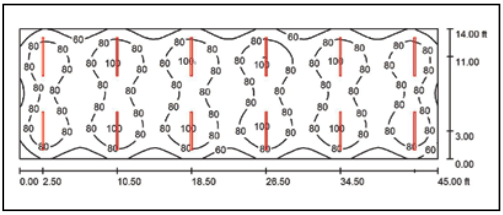The Importance of Light Uniformity
Managing light is obviously critical to the production of crops grown in controlled environments. When considering the different dimensions of light, we usually focus on photoperiod (day length), light quantity (intensity) and light quality (the spectral distribution).
An often ignored parameter is light uniformity, which refers to how well light is evenly distributed to a growing area. Light uniformity should be a consideration when deciding the orientation and glazing of new greenhouses, installing greenhouse shading systems, and for plant lighting installations, including photoperiodic, supplemental and sole-source lighting applications.
In the production of greenhouse or indoor crops, I believe that light uniformity is equally important as light intensity. The uniformity of the light environment has a large impact on the uniformity of the crop. Light regulates crop growth, plant development (including flowering), as well as how quickly plants use water.

When the light conditions in a growing area are not uniform, plants dry out at different rates, those under higher light often grow more and develop faster, and soon managing those crops with those that receive less light (and are smaller) becomes quite difficult.
Greenhouse orientation. Most greenhouses in temperate climates are oriented north-south because as the sun travels east-west, the shadows cast from the infrastructure move during the day. In an east-west greenhouse, the shadows don’t move much with the sun, creating dark spots. Generally, east-west-oriented greenhouses transmit more light, but the consequence of less uniform light conditions means that for most crops and situations, a north-south orientation is recommended.
Glazing and shade screens. A recent trend, especially for high-wire vegetable crops such as tomato and cucumber, is the use of diffused glass as a greenhouse glazing material and plastics in shade curtains that diffuse sunlight (for more: www. gpnmag.com/article/diffused-glass). The primary advantage of these new technologies is an increase in light uniformity, both horizontally and vertically. They decrease the intensity of bright spots and increase the intensity of dark spots in the greenhouse, which evens out crop growth and in some cases, can actually increase fruit yield.
Plant lighting. The importance of light uniformity applies to all plant lighting applications. Unequal light levels in greenhouses or indoors create different photosynthetic daily light integrals, which create different plant growth responses. Similarly, if photoperiodic lighting is not uniform, creating locations in which the intensity is too low for plant perception, flowering of daylength-sensitive crops will be less uniform.
When considering greenhouse supplemental lighting options, be sure to obtain a light intensity map (which resembles a contour map) from the lighting company or supplier (Figure 1). These maps show the expected variation in light intensity after installation, should be developed specifically for your greenhouse and desired installation, and should be reported in μmol∙m–2∙s–1 of photosynthetic light. For example in Figure 1, most locations are around 80 μmol∙m–2∙s–1, with a higher intensity (100 μmol∙m–2∙s–1) just below the lamps and a lower intensity (60 μmol∙m–2∙s–1) at the edges.
To obtain a light map, you will need to provide the company your greenhouse dimensions (including lamp hanging height) and they will use information for the light output of each lamp type to create an intensity map, showing the placement of fixtures and the expected light levels. Generally, a 10-20 percent variation in intensity is acceptable.
Light uniformity is even more important indoors with sole-source lighting. Here, light variation is often extreme, and differences in intensity of 50 percent or more are not uncommon. As the vertical farming industry develops, hopefully more attention will be paid to light uniformity and its importance in growing uniform crops.
Erik Runkle is professor and floriculture extension specialist in the department of horticulture at Michigan State University. He can be reached at runkleer@msu.edu.









 Video Library
Video Library 


















